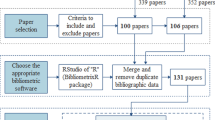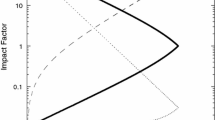Abstract
It is shown how Bradford curves, i.e. cumulative rank-frequency functions, as used in informetrics, can describe the fragment size distribution of percolation models. This interesting fact is explained by arguing that some aspects of percolation can be interpreted as a model for the success-breeds-success or cumulative advantage phenomenon. We claim, moreover, that the percolation model can be used as a model to study (generalised) bibliographies. This article shows how ideas and techniques studied and developed in informetrics and scientometrics can successfully be applied in other fields of science, and vice versa.
Similar content being viewed by others
References
R. Rousseau, S. Rousseau, Informetric distributions: a tutorial review, Canadian Journal of Information and Library Science, 18 (1993) 51-63.
R. Rousseau, Bradford curves, Information Processing & Management, 30 (1994) 267-277.
S. C. Bradford, Sources of information on specific subjects, Engineering, 137 (1934) 85-86. Reprinted in: Journal of Information Sciences, 10 (1985) 176–180.
R. Rousseau, Lotka's law and its Leimkuhler representation, Library Science with a Slant to Documentation and Information Studies, 25 (1988) 150-178.
R. Rousseau, A weak goodness-of-fit test for rank-frequency distributions. In: C. Macias-Chapula (Ed.), Proceedings of the Seventh Conference of the International Society for Scientometrics and Informetrics, Universidad de Colima (Mexico), 1999, 421-430.
A. Bunde, S. Havlin, A brief introduction to fractal geometry. in: A. Bunde, S. Havlin (Eds), Fractals in Science, Springer-Verlag, Berlin, 1995, 1-25.
D. Stauffer, Introduction to Percolation Theory. Taylor & Francis, London, UK, 1985.
G. Grimmett, Percolation, New York (etc.): Springer-Verlag (1989).
J. Bogaert, I. Impens, Generating random percolation clusters, Applied Mathematics and Computation, 91 (1998) 197-208.
J. Bogaert, P. Van Hecke, R. Moermans, I. Impens, Twist number statistics as an additional measure of habitat perimeter irregularity, Environmental and Ecological Statistics, 9 (1999) 275-290.
R. H. Gardner, B. T. Milne, M. G. Turner, R. V. O'Neill, Neutral models for the analysis of broad-scale landscape pattern, Landscape Ecology, 1 (1987) 19-28.
R. H. Gardner, M. G. Turner, V. H. Dale, R. V. O'Neill, A percolation model of ecological flows, In: A. J. Hansen, F. Di Castri (Eds) Landscape Boundaries. Consequences for Biotic Diversity and Ecological Flows, Springer-Verlag, New York, USA, 1992, 259-269.
K. A. With, A. W. King, The use and misuse of neutral landscape models in ecology, Oikos, 79 (1997) 219-299.
R. T. T. Forman, Land Mosaics. The Ecology of Landscapes and Regions, Cambridge University Press, Cambridge, UK., 1997, p. 406.
D. J. Bender, T. A. Contreras, L. Fahrig, Habitat loss and population decline: a meta-analysis of the patch size effect, Ecology, 79 (1998) 517-533.
M. J. Groom, N. Schumacker, Evaluating landscape change: patterns of worldwide deforestation and local fragmentation, In: P. M. Kareiva, J. G. Kingsolver & R. B. Huey (Eds), Biotic Interactions and Global Change, Sinauer Associates Inc., Sunderland, MA, USA, 1993, 24-44.
J. M. Lord, D. A. Norton, Scale and the spatial concept of fragmentation, Conservation Biology, 4 (1990) 197-202.
D. A. Saunders, R. J. Hobbs, C. R. Margules, Biological consequences of ecosystem fragmentation: a review, Conservation Biology, 5 (1991) 18-32.
A. Farina, Principles and Methods in Landscape Ecology, Chapman & Hall, London, UK, 1998, p. 58.
L. Egghe, Bridging the gaps — conceptual discussions on informetrics, Scientometrics, 30 (1994) 35-47.
B. F. J. Manly, Randomization and Monte Carlo Methods in Biology, Chapman & Hall, London, UK, 1991, pp 38-42.
USA-CERL, GRASS 4.1 User's reference manual, United States Army Corps of Engineers. Construction Engineering Research Laboratories, Champaign, Illinois, USA, 1993.
D. Nijssen, R. Rousseau, P. Van Hecke, The Lorenz curve: a graphical representation of evenness, Coenoses, 13 (1998) 33-38.
H. A. Simon, On a class of skew distributions, Information and Control, 52 (1955) 425-440.
D. De Solla Price, A general theory of bibliometric and other cumulative advantage processes, Journal of the American Society for Information Science, 27 (1976) 292-306.
J. Tague, The success-breeds-success phenomenon and bibliometric processes, Journal of the American Society for Information Science, 32 (1981) 280-286.
W. GlÄnzel, A. Schubert, The cumulative advantage function. A mathermatical formulation based on conditional expectations and its application to scientometric distributions, In: L. Egghe, R. Rousseau (Eds), Informetrics 89/90, Amsterdam, Elsevier, 1990, 139-147.
Y.-S. Chen, P. P. Chong, M. Y. Tong, Dynamic behavior of Bradford's law, Journal of the American Society for Information Science, 46 (1995) 370-383.
L. Egghe, R. Rousseau, Generalized success-breeds-success principle leading to time-dependent informetric distributions, Journal of the American Society for Information Science, 46 (1995) 426-445.
G. M. Braga, Some aspects of the Bradford's distribution, Proceedings of the American Society for Information Science Annual Meeting, 29 (1978) 51-54.
V. OluiĆ-VukoviĆ, Journal productivity distribution: quantitative study of dynamic behavior, Journal of the American Society for Information Science, 43 (1992) 412-421.
Author information
Authors and Affiliations
Rights and permissions
About this article
Cite this article
Bogaert, J., Rousseau, R. & Van Hecke, P. Percolation as a Model for Informetric Distributions: Fragment Size Distribution Characterised by Bradford Curves. Scientometrics 47, 195–206 (2000). https://doi.org/10.1023/A:1005678707987
Issue Date:
DOI: https://doi.org/10.1023/A:1005678707987




